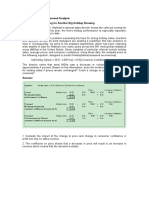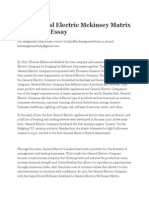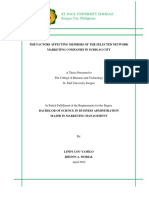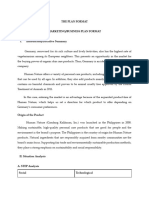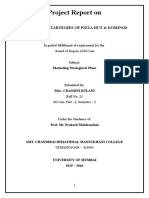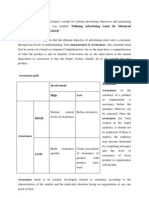SWOT Analysis Nestlé
SWOT Analysis Nestlé
Uploaded by
Arbee Dela Cruz AgdonCopyright:
Available Formats
SWOT Analysis Nestlé
SWOT Analysis Nestlé
Uploaded by
Arbee Dela Cruz AgdonCopyright
Available Formats
Share this document
Did you find this document useful?
Is this content inappropriate?
Copyright:
Available Formats
SWOT Analysis Nestlé
SWOT Analysis Nestlé
Uploaded by
Arbee Dela Cruz AgdonCopyright:
Available Formats
SWOT Analysis Nestl
Strengths
Global food producer, located in over 100 countries. Consistently one of the world's largest producers of food products, with sales in the USA in 2008 of $10 billion; sales and earnings in 2008 were better than expected, even in a downturned economy. Global sales in 2008 topped $101 billion.
Weaknesses
Their LC-1 division was not as successful as they thought it would be in France. In the late 1980s, Dannon entered the market with a health-based yogurt, and become the top selling brand of yogurt; Nestl's 1994 launch was behind the product life cycle curve in an already mature market and could not compete against a strong, established brand. Growth in their organic food sales division was flat in 2008, even though the industry grew 8.9%. Since 2004 the breakfast cereal industry has been under fire from the FDA and the American Medical Association, both of which say that false claims of "heart healthy" and "lower cholesterol" need to be removed from packaging and advertising. They have also been forced to reduce the amount of sugar in their products, as parent's advocates groups claimed they were contributing to the diabetes epidemic among American children. General Mills is an experienced, established brand and are the market leader in the USA, however, they have been lacking in innovation, have not cashed in on the booming health food craze and have been behind in creating new, niche products, especially in their yogurt division, where Yoplait is the only brand making a profit. In 2008, although their products did not carry the recalled pistachios, several of their ice cream brands, Dryer's, Edy's and Haagen-Dazs, were still plagued with bad PR and loss of sales.
Opportunities
In today's health conscious societies, they can introduce more health-based products, and because they are a market leader, they would likely be more successful. Provide allergen free food items, such as gluten free and peanut free. They launched a new premium line of higher cacao content chocolates dubbed Nestl Treasures Gold, in order to cash in on the "recession economy" in which consumers cut back on luxury goods, but regularly indulge in candy and chocolate. Americans want luxury chocolates, and high-end chocolate is immune to the recession (so far), because it is an inexpensive indulgence. Open Nestl Caf's in major cities to feature Nestl products.
Threats
Any contamination of the food supply, especially e-coli. Their Toll House brand cookie dough was recalled in March of 2009 because of e-coli. Outbreaks were linked to 28 states and the product had to be recalled globally. Nestl has yet to find out how this happened, and is still investigating. They were affected by the pet food recall in 2007, in which 95 different brands of dog and cat food were recalled due to contamination with rat poison. Also in 2007, FDA learned that certain pet foods were sickening and killing cats and dogs. FDA found contaminants in vegetable proteins imported into the United States from China and used as ingredients in pet food. Raw chocolate ingredient prices are soaring; dairy costs alone rose 50% in 2008, this cuts heavily into their profit margins and often gets passed on to consumers, by shrinking the packaging in a way that is almost unnoticeable-therefore the consumer is paying the same prices for less product. They have major competitors, like Hershey's, Cadbury-Schweppes (owned by Pepsi), Lindt and Ghirardelli, Kellogg's, Post, Starbucks, Beech-Nut, Quaker, Kraft Foods, Dannon, Del-Monte, Iams, Earth's Best, Heinz, Frito-Lay (owned by Pepsi).
CASE STUDY NESTLE
Introduction Nestl is today the worlds leading food company, with a 135-year history and operations in virtually every country in the world. Nestls principal assets are not office buildings, factories, or even brands. Rather, it is the fact that they are a global organization comprised of many nationalities, religions, and ethnic backgrounds all working together in one single unifying corporate culture. Culture at Nestl and Human Resources Policy Nestl culture unifies people on all continents. The most important parts of Nestls business strategy and culture are the development of human capacity in each country where they operate. Learning is an integral part of Nestls culture. This is firmly stated in The Nestl Human Resources Policy, a totally new policy that encompasses the guidelines that constitute a sound basis for efficient and effective human resource management. People development is the driving force of the policy, which includes clear principles on non-discrimination, the right of collective bargaining as well as the strict prohibition of any form of harassment. The policy deals with recruitment, remuneration and training and development and emphasizes individual responsibility, strong leadership and a commitment to life-long learning as required characteristics for Nestl managers.
Training Programs at Nestl The willingness to learn is therefore an essential condition to be employed by Nestl. First and foremost, training is done on-the-job. Guiding and coaching is part of the responsibility of each manager and is crucial to make each one progress in his/her position. Formal training programs are generally purpose-oriented and designed to improve relevant skills and competencies. Therefore they are proposed in the framework of individual development programs and not as a reward. Literacy Training Most of Nestls people development programs assume a good basic education on the part of employees. However, in a number of countries, we have decided to offer employees the opportunity to upgrade their essential literacy skills. A number of Nestl companies have therefore set up special programs for those who, for one reason or another, missed a large part of their elementary schooling. These programs are especially important as they introduce increasingly sophisticated production techniques into each country where they operate. As the level of technology in Nestl factories has steadily risen, the need for training has increased at all levels. Much of this is on-the-job training to develop the specific skills to operate more advanced equipment. But its not only new technical abilities that are required. Its sometimes new working practices. For example, more flexibility and more independence among work teams are sometimes needed if equipment is to operate at maximum efficiency. Sometimes we have debates in class and we are afraid to stand up. But our facilitators tell us to stand up because one day we might be in the parliament! (Maria Modiba, Production line worker, Babelegi factory, Nestl South Africa). Nestl Apprenticeship Program
Apprenticeship programs have been an essential part of Nestl training where the young trainees spent three days a week at work and two at school. Positive results observed but some of these soon ran into a problem. At the end of training, many students were hired away by other companies which provided no training of their own. My two elder brothers worked here before me. Like them, for me the Nestl Apprenticeship Program in Nigeria will not be the end of my training but it will provide me with the right base for further advancement. We should have more apprentices here as we are trained so well! (John Edobor Eghoghon, Apprentice Mechanic, Agbara Factory, Nestl Nigeria) Its not only a matter of learning bakery; we also learn about microbiology, finance, budgeting, costs, sales, how to treat the customer, and so on. That is the reason I think that this is really something that is going to give meaning to my life. It will be very useful for everything. (Jair Andrs Santa, Apprentice Baker, La Rosa Factory Dosquebradas, Nestl Columbia). Local Training Two-thirds of all Nestl employees work in factories, most of which organize continuous training to meet their specific needs. In addition, a number of Nestl operating companies run their own residential training centers. The result is that local training is the largest component of Nestls people development activities worldwide and a substantial majority of the companys 240000 employees receive training every year. Ensuring appropriate and continuous training is an official part of every managers responsibilities and, in many cases; the manager is personally involved in the teaching. For this reason, part of the training structure in every company is focused on developing managers own coaching skills. Additional courses are held outside the factory when required, generally in connection with the operation of new technology. The variety of programs is very extensive. They start with continuation training for exapprentices who have the potential to become supervisors or section leaders, and continue through several levels of technical, electrical and maintenance engineering as well as IT management. The degree to which factories develop home-grown specialists varies considerably, reflecting the availability of trained people on the job market in each country. Onthe-job training is also a key element of career development in commercial and administrative positions. Here too, most courses are delivered in-house by Nestl trainers but, as the level rises, collaboration with external institutes increases. As part of the Young Managers Training Program I was sent to a different part of the country and began by selling small portions of our Maggi bouillon cubes to the street stalls, the sari sari stores, in my country. Even though most of my main key accounts are now supermarkets, this early exposure were an invaluable learning experience and will help me all my life. (Diane Jennifer Zabala, Key Account Specialist, Sales, Nestle Philippines). Through its education and training program, Nestl manifests its belief that people are the most important asset. In my case, I was fortunate to participate in Nestls Young Managers Program at the start of my Nestl career, in 1967. This foundation has sustained me all these years up to my present position of CEO of one of the top 12 Nestl companies in the world. (Juan Santos, CEO, Nestl Philippines) Virtually every national Nestl company organizes management-training courses for new employees with High school or university qualifications. But their approaches vary considerably. In Japan, for example, they consist of a series of short courses typically lasting three days each.
Subjects include human assessment skills, leadership and strategy as well as courses for new supervisors and new key staff. In Mexico, Nestl set up a national training center in 1965. In addition to those following regular training programs, some 100 people follow programs for young managers there every year. These are based on a series of modules that allows tailored courses to be offered to each participant. Nestl Pakistan runs 12-month programs for management trainees in sales and marketing, finance and human resources, as well as in milk collection and agricultural services. These involve periods of fieldwork, not only to develop a broad range of skills but also to introduce new employees to company organization and systems. The scope of local training is expanding. The growing familiarity with information technology has enabled distance learning to become a valuable resource, and many Nestl companies have appointed corporate training assistants in this area. It has the great advantage of allowing students to select courses that meet their individual needs and do the work at their own pace, at convenient times. In Singapore, to quote just one example, staff is given financial help to take evening courses in job-related subjects. Fees and expenses are reimbursed for successfully following courses leading to a trade certificate, a high school diploma, university entrance qualifications, and a bachelors degree. International Training Nestls success in growing local companies in each country has been highly influenced by the functioning of its international Training Centre, located near our companys corporate headquarters in Switzerland. For over 30 years, the Rive-Reine International Training Centre has brought together managers from around the world to learn from senior Nestl managers and from each other.Country managers decide who attends which course, although there is central screening for qualifications, and classes are carefully composed to include people with a range of geographic and functional backgrounds. Typically a class contains 1520 nationalities. The Centre delivers some 70 courses, attended by about 1700 managers each year from over 80 countries. All course leaders are Nestl managers with many years of experience in a range of countries. Only 25% of the teaching is done by outside professionals, as the primary faculty is the Nestl senior management. The programs can be broadly divided into two groups: Management courses: these account for about 66% of all courses at Rive-Reine. The participants have typically been with the company for four to five years. The intention is to develop a real appreciation of Nestl values and business approaches. These courses focus on internal activities. Executive courses: these classes often contain people who have attended a management course five to ten years earlier. The focus is on developing the ability to represent Nestl externally and to work with outsiders. It emphasizes industry analysis, often asking: What would you do if you were a competitor? Conclusion Nestls overarching principle is that each employee should have the opportunity to develop to the maximum of his or her potential. Nestl do this because they believe it pays off in the long run in their business results, and that sustainable long-term relationships with highly competent
people and with the communities where they operate enhance their ability to make consistent profits. It is important to give people the opportunities for life-long learning as at Nestle that all employees are called upon to upgrade their skills in a fast-changing world. By offering opportunities to develop, they not only enrich themselves as a company, they also make themselves individually more autonomous, confident, and, in turn, more employable and open to new positions within the company. Enhancing this virtuous circle is the ultimate goal of their training efforts at many different levels through the thousands of training programs they run each year.
Pest Analysis Of Nestle Philippines Essays and Term Papers
You might also like
- River Island SWOT and PESTLEDocument15 pagesRiver Island SWOT and PESTLEpezzy0% (1)
- mktg3007 - 20172 Retail Marketing and Distribution Final Exam Past Year QuestionsDocument4 pagesmktg3007 - 20172 Retail Marketing and Distribution Final Exam Past Year QuestionsKaylly Julius50% (2)
- Volvo Truck - Penetrating The US MarketDocument5 pagesVolvo Truck - Penetrating The US MarketKha NguyenNo ratings yet
- Wrigley's Eclipse Gum - Case Analysis Report: 1. Key Issues/ProblemsDocument4 pagesWrigley's Eclipse Gum - Case Analysis Report: 1. Key Issues/ProblemsAkaash HegdeNo ratings yet
- Final Presentation - AccountingDocument41 pagesFinal Presentation - AccountingViễn Nguyễn KýNo ratings yet
- Application - of - Economic - Concepts-Activity - 2 KATRINA AMORE VINARAODocument7 pagesApplication - of - Economic - Concepts-Activity - 2 KATRINA AMORE VINARAOKatrina Amore VinaraoNo ratings yet
- Teh Tarik PlaceDocument6 pagesTeh Tarik PlaceWan Shakiki MazlanNo ratings yet
- Efe MatrixDocument1 pageEfe MatrixynuhhteeNo ratings yet
- Tor - Mba Project - Walls Trikes Research - 1Document10 pagesTor - Mba Project - Walls Trikes Research - 1Hoorain KapadiaNo ratings yet
- The End of Hanjin ShippingDocument8 pagesThe End of Hanjin ShippingAna VBNo ratings yet
- Case Study On UnileverDocument4 pagesCase Study On UnilevermonikaNo ratings yet
- Starbucks Introduction in ItalyDocument2 pagesStarbucks Introduction in ItalyFrancesco GrtNo ratings yet
- WARBURTONS CASE STUDY KDocument6 pagesWARBURTONS CASE STUDY KAdorablé PerezNo ratings yet
- Answers To Case1Document3 pagesAnswers To Case1Dinesh Raghavendra100% (2)
- Philippines Telecommunications Industry Report, 2019-2025: Published: November 2019Document10 pagesPhilippines Telecommunications Industry Report, 2019-2025: Published: November 2019nguyenhaiidcNo ratings yet
- Dyanmics of Strategy PaperDocument40 pagesDyanmics of Strategy PaperMarianne Sammy100% (2)
- Quijano Philippine Seven Corp Entre 7 Submission 2Document5 pagesQuijano Philippine Seven Corp Entre 7 Submission 2Nadya Quijano100% (1)
- Muna - MKTM033 - Opportunity Analysis A 1 - 09.12.2017 - ReviewedDocument11 pagesMuna - MKTM033 - Opportunity Analysis A 1 - 09.12.2017 - Reviewedsubha005No ratings yet
- Agarwood and Oud Oil Quarterly Market Price Report - Sep 2015Document14 pagesAgarwood and Oud Oil Quarterly Market Price Report - Sep 2015fais_subohNo ratings yet
- NTTA To Post List of Top DeadbeatsDocument2 pagesNTTA To Post List of Top DeadbeatsDavid SchechterNo ratings yet
- Synopsis On Brand AarenessDocument2 pagesSynopsis On Brand AarenessMinal SinghNo ratings yet
- Dunlop TyresDocument92 pagesDunlop TyresSubramanya DgNo ratings yet
- Confectionery and Chocolate Industry of Pakistan in 2009 Is An Analysis of BrandedDocument10 pagesConfectionery and Chocolate Industry of Pakistan in 2009 Is An Analysis of BrandedUsman Uddin KhanNo ratings yet
- Cim Case Study July 2023 Shell PLC (21.05.2023)Document112 pagesCim Case Study July 2023 Shell PLC (21.05.2023)Kumuditha KalpageNo ratings yet
- Price Elasticity of SupplyDocument26 pagesPrice Elasticity of SupplyjiskanNo ratings yet
- Candyland Novella Term ProjectDocument15 pagesCandyland Novella Term Projectbatool mehdiNo ratings yet
- Halliburton Swot & Pestle Analysis: © Barakaat Consulting - An Ezzy IT Consulting BusinessDocument7 pagesHalliburton Swot & Pestle Analysis: © Barakaat Consulting - An Ezzy IT Consulting BusinessCarlo Moivre0% (1)
- Marketing Assignment - FinalDocument14 pagesMarketing Assignment - FinalMohammed AldhounNo ratings yet
- Ch-1 Consumer Behavior: Its Origins and Strategic ApplicationsDocument19 pagesCh-1 Consumer Behavior: Its Origins and Strategic ApplicationsNasir HossenNo ratings yet
- MNC and OutsourcingDocument52 pagesMNC and OutsourcingsudeendraNo ratings yet
- Coca Cola Swot Analysis-RevisedDocument7 pagesCoca Cola Swot Analysis-RevisedRobbie Cruz0% (2)
- Global Market ParticipationDocument24 pagesGlobal Market ParticipationCharlene Joy PrudenteNo ratings yet
- Swot Matrix of UniqloDocument2 pagesSwot Matrix of UniqloHi Kar WaiNo ratings yet
- Case Study NestleDocument5 pagesCase Study NestleRidwan Ridho PuteraNo ratings yet
- PESTLE Analysis of SingaporeDocument3 pagesPESTLE Analysis of Singaporejason LuvNo ratings yet
- Supermarkets in The Philippines AnalysisDocument2 pagesSupermarkets in The Philippines AnalysisAndrea YvestroNo ratings yet
- The General Electric Mckinsey Matrix Marketing EssayDocument7 pagesThe General Electric Mckinsey Matrix Marketing EssayHND Assignment HelpNo ratings yet
- Strategic Management Regis 0 PDFDocument34 pagesStrategic Management Regis 0 PDFKhristine PerezNo ratings yet
- Coca Cola: A Study On The Marketing Strategies For Millenniums Focusing On IndiaDocument7 pagesCoca Cola: A Study On The Marketing Strategies For Millenniums Focusing On IndiaAsckani ManuelNo ratings yet
- PEST Soft Drinks IndustryDocument16 pagesPEST Soft Drinks Industryannekaren23No ratings yet
- History of Baskin RobbinsDocument3 pagesHistory of Baskin RobbinsMarcus Thong33% (3)
- University of Santo Tomas: Araneta Center, IncDocument90 pagesUniversity of Santo Tomas: Araneta Center, IncloombandNo ratings yet
- Components of VMDocument15 pagesComponents of VMNadine YbascoNo ratings yet
- Strategic AlliancesDocument3 pagesStrategic AlliancesSukesh RNo ratings yet
- Yamilo & Morial ThesisDocument30 pagesYamilo & Morial ThesisLindy Lou YamiloNo ratings yet
- Swot N Pest Analysis of Nestle and Coca ColaDocument4 pagesSwot N Pest Analysis of Nestle and Coca Colad-fbuser-18320266100% (2)
- Chapter 8: The Marketing MixDocument45 pagesChapter 8: The Marketing MixDeepshikha YadavNo ratings yet
- Pizza Hut ProjectDocument37 pagesPizza Hut ProjectUsman IslamNo ratings yet
- Bristol Institute of Business Management: UMKDFG-15-M Customer and International Market Analysis Feasiblity ReportDocument14 pagesBristol Institute of Business Management: UMKDFG-15-M Customer and International Market Analysis Feasiblity Reportbashini chathurikaNo ratings yet
- International StrategyDocument23 pagesInternational StrategyKendrew SujideNo ratings yet
- Best Human Nature Marketing PlanDocument21 pagesBest Human Nature Marketing PlanCarlos Maglutac,No ratings yet
- Case Study LSI LogicDocument2 pagesCase Study LSI Logicvikas joshiNo ratings yet
- Cable Car SemiDocument23 pagesCable Car Semimiracle123100% (1)
- XeroxDocument6 pagesXeroxirinaestefania100% (1)
- Sun Life FinancialDocument2 pagesSun Life Financialchristine geronimo100% (1)
- G7 - Monopoly and Oligopoly Cases PrintDocument11 pagesG7 - Monopoly and Oligopoly Cases PrintboeNo ratings yet
- DLSU MBA Operations Management Term Paper FinalDocument36 pagesDLSU MBA Operations Management Term Paper Finalfccts38No ratings yet
- HYGEIA INTERNATIONAL AND APG - Rev1Document5 pagesHYGEIA INTERNATIONAL AND APG - Rev1Mikaela PadillaNo ratings yet
- 1 MBSA1463 FEEP QUESTION Sem 1 20232024Document4 pages1 MBSA1463 FEEP QUESTION Sem 1 20232024suzieanaNo ratings yet
- Strategic Management BOAST COMPANYDocument55 pagesStrategic Management BOAST COMPANYPamela Ledesma SusonNo ratings yet
- Report On Dominos Vs Pizza HutDocument50 pagesReport On Dominos Vs Pizza Hutjagrati agrawalNo ratings yet
- International StrategyDocument34 pagesInternational StrategymanicatewatiaNo ratings yet
- Pest AnalysisDocument26 pagesPest AnalysisNeha Sharma100% (1)
- Car Price Differentials Case - IBDocument10 pagesCar Price Differentials Case - IBNishanth M S Hebbar100% (1)
- Value Chain Management Capability A Complete Guide - 2020 EditionFrom EverandValue Chain Management Capability A Complete Guide - 2020 EditionNo ratings yet
- Guidelines for African Swine Fever (ASF) prevention and Control in Smallholder Pig Farming in Asia: Clean Chain Approach for African Swine Fever in Smallholder SettingsFrom EverandGuidelines for African Swine Fever (ASF) prevention and Control in Smallholder Pig Farming in Asia: Clean Chain Approach for African Swine Fever in Smallholder SettingsNo ratings yet
- Case Study - Nestle - Mod 01Document6 pagesCase Study - Nestle - Mod 01Lakshmi KsrinivasNo ratings yet
- Reliance Fresh SWOTDocument6 pagesReliance Fresh SWOTtannipodder120% (1)
- Tata Group Is An Indian Multinational Conglomerate Company Headquartered in MumbaiDocument46 pagesTata Group Is An Indian Multinational Conglomerate Company Headquartered in MumbaiAnita VarmaNo ratings yet
- Eco 162 - Quiz 1 FEB 2014Document3 pagesEco 162 - Quiz 1 FEB 2014Luqman LatifNo ratings yet
- CadburyDocument12 pagesCadburymldc20110% (1)
- Report On Pizza Town SukkurDocument5 pagesReport On Pizza Town Sukkuraamir aliNo ratings yet
- Demand and Supply - Group DiscussionDocument3 pagesDemand and Supply - Group DiscussionNhat Linh HuynhNo ratings yet
- Category IdentificationDocument3 pagesCategory IdentificationSarwar IqbalNo ratings yet
- ImcDocument20 pagesImcsufyanNo ratings yet
- Consumer CreditDocument12 pagesConsumer CreditDrpranav Saraswat100% (3)
- Consumer Choice and Demand: Dr. Ir. Yooce Yustiana M.SiDocument14 pagesConsumer Choice and Demand: Dr. Ir. Yooce Yustiana M.SiSanti ElviraNo ratings yet
- Indomie PricingDocument3 pagesIndomie PricingKumar ShashwatNo ratings yet
- 12 Principles of Marketing Week 8 Module 7Document4 pages12 Principles of Marketing Week 8 Module 7Rebecca MarasiganNo ratings yet
- Article On CRMDocument3 pagesArticle On CRMKarrizzmaticNo ratings yet
- Beauty and Personal Care in IndonesiaDocument19 pagesBeauty and Personal Care in IndonesianamasayaratihNo ratings yet
- Product Quality of ShareteaDocument7 pagesProduct Quality of ShareteaCassie Bautista0% (1)
- Dagmar ApproachDocument4 pagesDagmar ApproachPrasun GoalaNo ratings yet
- Consumer Information FssaiDocument41 pagesConsumer Information FssaiSiddhartha Kumar100% (1)
- Food LawDocument33 pagesFood Lawervaishali100% (1)
- Qabco English TestDocument19 pagesQabco English TestFA AyNo ratings yet
- Crisis Management and Contigency PlanningDocument2 pagesCrisis Management and Contigency Planningrivaille yaegerNo ratings yet
- American Express: Small Business SaturdayDocument2 pagesAmerican Express: Small Business SaturdaySHIVANSHU PANDEYNo ratings yet
- Lecture16-Price Elasticity of DemandDocument50 pagesLecture16-Price Elasticity of DemandSergio VinsennauNo ratings yet
- Types of ProductionDocument2 pagesTypes of ProductionromwamaNo ratings yet





